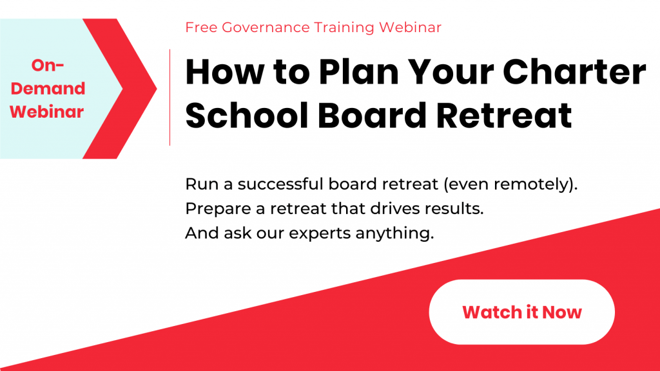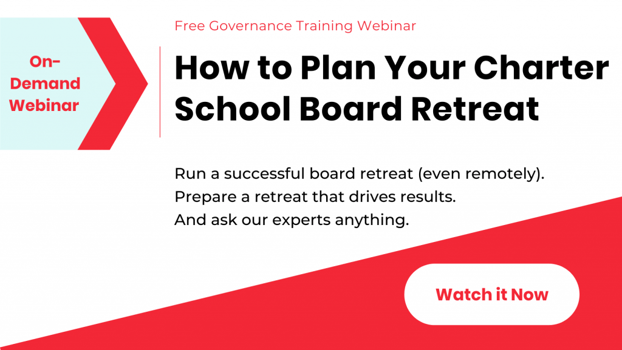
Annual Board Retreats: Answers to the Most Common Questions
Planning your charter school board retreat is an important undertaking.
We’ve provided extensive advice on what to include in your board retreat agenda, how to prepare for your board retreat with a board assessment, and why even hold a board retreat.
Here, we’ll answer the most commonly asked questions about planning and holding a board retreat. Below, you’ll find answers to:
- Why should we hold an annual board retreat?
- Will you cover your board’s annual meeting requirements at your retreat?
- Who should attend a charter school board retreat?
- How much time does a board retreat need to take?
- When should we hold our board retreat?
- Where should we host our board retreat?
- How much should our board retreat cost?
- Should I bring in an outside board retreat facilitator?
- What should board members do to prepare for a board retreat?
- How do you know your board retreat was successful?
- Is our retreat subject to open meeting laws?

Why should we hold an annual board retreat?
Annual board retreats help you make the most strategic use of your trustees’ limited time. And they’re where the deep, strategic work gets done.
There’s so much work that boards need to get done. And there’s simply not enough time to do it.
To find the time for the strategic planning the organization is looking to its board to contribute, let alone your internal planning to improve as a board, you have to set time aside every year to reflect at a retreat.
Learn more about the reasons to hold an annual board retreat.
Will you cover your board’s annual meeting requirements at your retreat?
Most charter schools’ bylaws will specify that you’re required to have an annual meeting. And that’s separate from your retreat. But you can combine the two.
The board’s annual meeting is generally more board housekeeping than strategic governance work.
It’s where you’ll do things like sign board member agreements and confirm your officers and committee chairs for the coming year.
Download our sample board member job descriptions, expectations, and agreements.
Why confirm your officers at your annual meeting?
Some boards still just assume that the board chair will continue on as chair again. They won’t plan to talk about it.
But, you certainly don’t want your busy volunteer board members to feel taken for granted and you want to give others an opportunity to lead. It’s best to be purposeful about nominating and confirming each board leadership role, each year.
And your board’s annual meeting is the place to do that.
Why sign board member agreements at your annual meeting?
Board members have two-and three-year terms. Even as a symbolic gesture, it’s a good idea that, on an annual basis, have everybody review your board member agreement and sign it so that they are kind of recommitting and reviewing.
Your annual meeting doesn’t have to take a ton of time. You might be able to blow through all of this in 30 minutes or an hour. Or, it can be a separate, short meeting, especially if that’s what’s specified in your bylaws.
Who should attend a charter school board retreat?
Every board member should attend. The goal is absolutely 100% board member participation.
If any board members are not able to attend, reschedule. But book your retreat far enough out in advance that people can block the time and plan to participate.
Board member engagement, reconnection, recommitting are just such big parts of doing your retreat. If you don’t have everybody on board, it raises lots of questions about commitment. Your board might wonder if you’re really set up for success.
If you’re going to have votes taken to, for example, elect officers, you’re going to need a quorum at a minimum because it’s going to be a public meeting.
Your CEO, school leader, executive director or the person that works directly with the board, they will need to be present.
Review your agenda to assess who else you’ll need in attendance. Maybe the senior members and C-Suite people? Staff members?
If your agenda includes talking about your board’s culture, talking about what’s working and what’s not within the board or between the board and the CEO, it may not be appropriate to have staff members there for those kinds of conversations.
However, if you’re spending a lot of time talking about things like organizational priorities, your staff should be present as well as your CAO.
Learn more about who does what at charter school board retreats.
How Much Time Does A Board Retreat Need to Take?
Traditionally retreats are day-long affairs. At a minimum, a retreat is normally a half-day to a full day, meaning, four to eight hours.
But there’s no standard required amount of time for board retreats.
You want to give yourself a sizable amount of time.
It needs to be substantially longer than a traditional board meeting.
At a minimum, a retreat is normally a half-day to a full day, meaning, four to eight hours.
You might even spread out across two days.
But it seems that each year people get busier and busier, so finding a full day where 100% of the trustees are available has become increasingly challenging.
Charter school boards are increasingly opting for two shorter strategic sessions. So, instead of one long day of 8 hours, breaking the work into two shorter 4-hour sessions.
Breaking it into two parts ensures there is follow-through and accountability. You might even spread out across two days.
This is common for larger organizations, like major colleges and universities. Board members might go stay in a hotel the night before, do a dinner together, and then the next morning meet all day at that hotel. This gives you the time needed to get the work done, and to build connections.
Or, you might do two nights, back to back. So, for the school committee that I served, we did hours during the week. We would do from 3pm to 8pm, two nights in a row. We used the whole first night and just some of the second night.
Bottom line: give yourself a sizable amount of time. Your retreat will be substantially longer than a regular board meeting.

When should we hold our board retreat?
Charter school board retreats normally happen once a year, in the summer.
Some boards do lead their retreat in the middle of the school year.
During the summer, you don’t have the constant churn of activities and deadlines that must be managed during the school year. So it’s the best time for charter school boards, CEOs, and senior staff to reflect and plan.
Over the summer, people’s schedules tend to be cleared up so this is the typical time to run a retreat. However, if the winter works best for you, just make sure you have one!
Some boards have started breaking their retreat up into multiple sessions throughout the year.
For instance, one BoardOnTrack member hosts three or four half-day sessions on Saturdays throughout the school year.
That way, the board never is asked to devote an entire day (or two) to board work, the board can select a different strategic governance topic to dig into together at each session, and one committee can do deep work in advance to prepare to lead a fruitful conversation with the board.
Making sure you actually lead a retreat every year is more important than adhering to the usual timing.
If you held a retreat in the middle of the school year, still consider a summer strategic planning session. You might need that to ensure you’ve met your organization’s needs this year and that your board is on track to contribute effectively in the coming year.
Decide what works best for your board. And prioritize getting every board member’s attendance.
Where should we host our board retreat?
This year, most people will likely hold their retreat remotely. Here’s advice for hosting your board retreat remotely.
However, if you’re hosting your retreat in person, you might meet where you normally hold your board meetings. Or, choose a new location.
Meeting away from where your board meetings are normally held gets you out of the typical environment and away from the monotony of the regular course of meetings. A local hotel or even a destination hotel area may be a great fit, depending on budget.
Ask your board members for help in finding a creative space to do the retreat.
Some retreats occur at your standard conference room, where you typically meet. This may work for some, especially large groups.
How Much Should Our Retreat Cost?
Be cautious of the expense. The expense of having everyone to a nice restaurant the night before a stay in a hotel room is a lot more than, say, having a really nice catered lunch or catered dinner in your meeting.
That said, your budget depends on the scale of things. You can have a board retreat that’s free if you don’t supply any food and things like that. Or, if you get food donated, it could also scale up to something more complex like with restaurants and hotels and travel expenses, etc.
In addition, if you’re seeking to do deep strategic planning, having somebody who can facilitate a strategic planning exercise about goal setting and things like that, following proven processes and systems, allows the CEO and the board chair all of the participants to be true participants.
You want to bring in a facilitator if you need the expertise and or in areas where you need everybody to be a full participant. If you need the CEO to not be taking notes and not thinking about where to go next and not brainstorming how to run the meeting, but can actually be there.
For some boards, having a facilitator is the right fit, others will keep it in house.
Should I bring in an outside retreat facilitator?
If you’re working with a facilitator like BoardOnTrack, then you do have expert help putting together your agenda. This can be a major help in efficiency and time management.
Bringing in an outside facilitator can cost anywhere from $1,000 to $10,000. The consultants’ fees normally include travel expenses, as well as services rendered.
If your agenda is really heavy on tough discussions… If you have a real toxic board culture, you might need to bring in an outside expert to facilitate those hard conversations. You might just know that, without the right external guidance, your retreat could go off the rails.
The really hard conversations can often be best facilitated by a disinterested facilitator. Because, within your governance team, there is no disinterested party — everyone’s invested.
In addition, if you’re seeking to do deep strategic planning, having somebody who can facilitate a strategic planning exercise about goal setting and things like that, following proven processes and systems, allows the CEO and the board chair all of the participants to be true participants.
You want to bring in a facilitator if you need the expertise and or in areas where you need everybody to be a full participant. If you need the CEO to not be taking notes and not thinking about where to go next and not brainstorming how to run the meeting, but can actually be there.
For some boards, having a facilitator is the right fit, others will keep it in house.
What should board members do to prepare for a board retreat?
The first thing is you need to get everybody on board with the notion of having one.
The CEO & Board Chair both need to be present and on board. It’s also great to get the full buy-in of the board.
Too many boards don’t do this, but it doesn’t hurt to get the full board to vote on doing a retreat. It validates, that this is something everyone on the team is committed to doing.
Next, we advise taking steps to lead a data-driven board retreat.
Start with completing a board assessment in advance of your board’s retreat.
You should also have completed your annual CEO evaluation.
If you’ve decided to have the board engage in on-demand board training in advance of the retreat, you’ll want to have decided what’s being assigned and made sure everyone has access to the resources.
How do you know your board retreat was successful?
The question here really is: How do we make it actionable?
A successful board retreat is one that results in a plan; that turns discussions and decisions into action.
An unproductive board retreat would be one in which everybody shows up, talks, debates, and leaves with no plan — or leaves with a plan but doesn’t actually follow up.
Sometimes, the actual goal-setting takes place in committee meetings following your retreat..
At the retreat, you might discuss whether or not you’re going to expand into another middle school, to chip away at your wait list.
You might come out of that conversation aligned on with the answer being, “Yes, we’re fully committed to this and we want it to happen within the next five years.”
Then, the action steps leaving the retreat would be that each committee will go back and set their own SMART goals for helping to reach that organizational-level goal.
Is our retreat subject to open meeting laws?
Some of your retreat may be and other parts may not. It depends on your agenda.
Part of the agenda might be a posted open public meeting of the board, where you actually might vote on official board business.
There may also be a closed session for your trustees’ learning and professional development, not actually doing any official business.
Whether you host your retreat on-site or in a secluded villa over a long weekend, whether you include staff or don’t, board retreats are an essential step in achieving your highest bar. Lean on BoardOnTrack to help you prepare and get the most out of your next retreat!
Learn more about complying with open meeting law at your board retreat.

Mike Mizzoni
With years in higher education, board governance, law, and state and local politics, Mike provides leadership and governance training to BoardOnTrack’s members.
